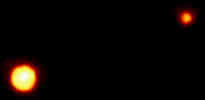Pluto
 Pluto is usually considered the last planet in the Solar System,
and certainly the last one discovered. Pluto is smaller than many of the
moons in the Solar System (including our own) and was discovered in 1930
by Clyde W. Tombaugh of the Percival Lowell observatory (a fact inherent
in its naming: PL= Pluto and Percival Lowell). It has not yet been visited
by any spacecraft so all our knowledge comes from observations like those
of the Hubble Space Telescope. Pluto is believed to be a huge rocky iceball
similar to a comet’s core or an asteroid. It is 70% rock and 30%
ice. Its atmosphere� is believed to contain frozen methane, ethane, and
carbon monoxide. It may resemble Neptune’s moon, Triton.
Pluto is usually considered the last planet in the Solar System,
and certainly the last one discovered. Pluto is smaller than many of the
moons in the Solar System (including our own) and was discovered in 1930
by Clyde W. Tombaugh of the Percival Lowell observatory (a fact inherent
in its naming: PL= Pluto and Percival Lowell). It has not yet been visited
by any spacecraft so all our knowledge comes from observations like those
of the Hubble Space Telescope. Pluto is believed to be a huge rocky iceball
similar to a comet’s core or an asteroid. It is 70% rock and 30%
ice. Its atmosphere� is believed to contain frozen methane, ethane, and
carbon monoxide. It may resemble Neptune’s moon, Triton.
Like Uranus, Pluto has at some time been knocked onto its side and it spins the other way to most planets.� Some observers have postulated that Pluto is merely a moon without a planet but the fact that it appears to have its own moon causes this theory trouble.
Pluto’s moon is Charon, a body almost the same size as Pluto, likewise knocked on its side and spinning backwards. It is also composed of rock, water, and ice. Often mistaken for a part of Pluto, Charon was discovered in 1978. It is proposed that Charon formed, like our moon, after colliding and combining with Pluto. Since they are so alike, astronomers have considered calling them a double moon/planet system rather than a moon orbiting a planet. The other interesting thing about Pluto and Charon is that Charon is in a geostationary orbit and therefore Pluto and its moon constantly face each other.
|
Diameter |
2, 271 km |
|
Mass |
�1.27 × 1022kg |
|
Mean Distance from sun |
�5,913,520,000 km |
|
Mean Density |
2.05 g/cm3 |
|
Rotational Period |
-6.4 Earth days* |
|
Orbital Period |
248.54 Earth years |
|
Mean Orbital Velocity |
4.74 km/s |
|
Atmosphere |
Methane, nitrogen |
|
Average Surface Temperature |
unknown |
|
Equatorial Surface Gravity |
0.66 m/s2 |
| Copyright owned by the State of Victoria (Department of Education and Early Childhood Development). Used with Permission. |
|
|||||||||||||||||||||||||||||||||||||||||||||||||||||||||||||||||||||||||||||||||||||